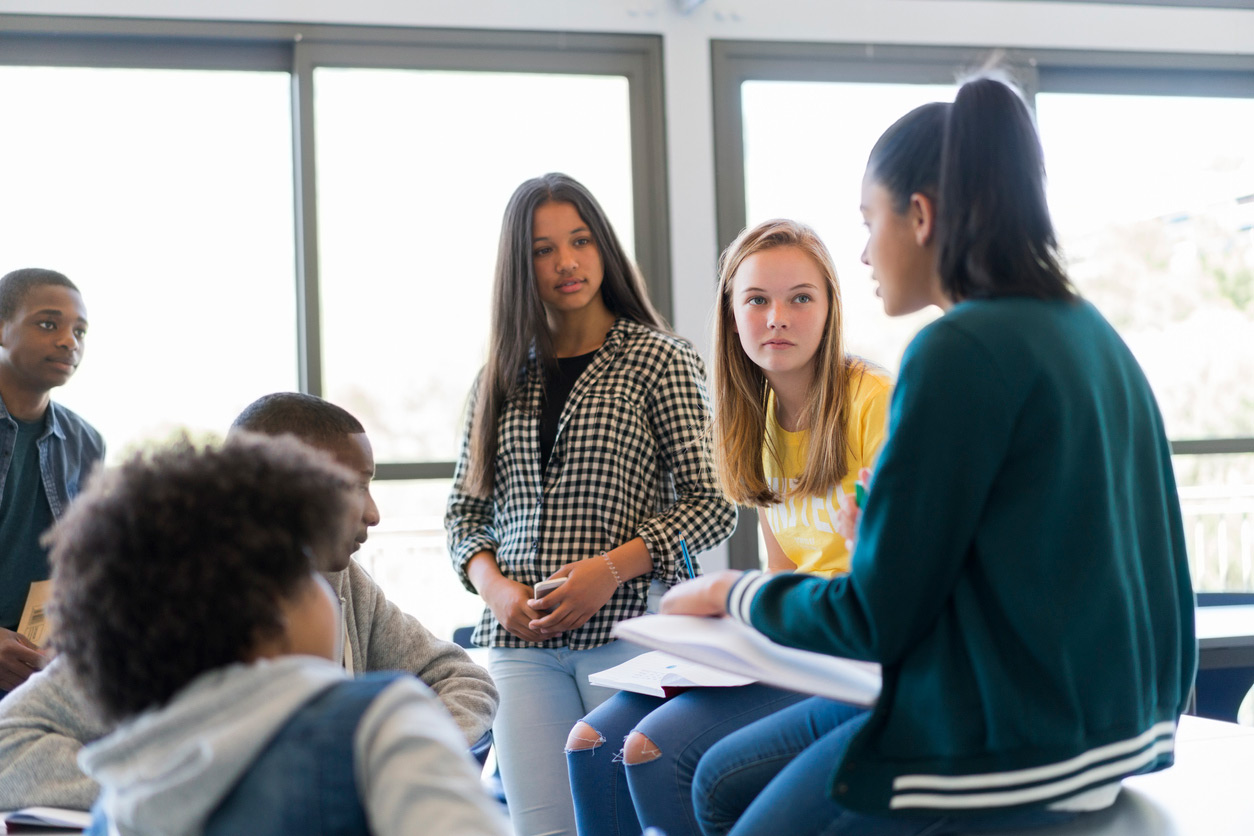TeacherVision partnered with PCG Education to bring you tips for how to make students thinking visible. We share teaching strategies that you can use in your classroom tomorrow that support students to learn and practice essential communication skills.

When It Doesn’t Go As Planned
The first time I facilitated a Socratic Seminar in my English classroom, it was a disaster. Despite thoughtful planning and what I thought were clear instructions and guidance, my students didn’t take ownership over managing their own discussion. Instead, they raised their hands, and looked to me to rescue them when inevitable moments of silence occurred.
I remember feeling very defeated. It was important to me that my students were able to articulate their thinking and that I built a classroom with an effective “talk” environment. I had Dead Poet Society type dreams for my English classroom where discussion was at the heart of everything we did, and my students were eager and willing participants.
If this sounds familiar, know that you aren’t alone. Too often we assume that students have the skills they need to facilitate a discussion with confidence. What I learned after that first Socratic Seminar, is that those skills need to be explicitly taught. The next question was, how do I do that?
"How do we build an effective “talk” environment in our classrooms? How do we guide our students to articulate their thinking?"
In this post, we partnered with PCG Education to share strategies and tips inspired by Jon Saphier’s course, Making Thinking Visible. To check out the course syllabus and learn more about Saphier’s framework, visit our professional development hub.
How Do We Make Student Thinking Visible?
The Tip: Equitable Participation
It is incredibly challenging to monitor and manage the process of calling on students. Inevitably, we always have students who raise their hands first and every time. In contrast, we have students who need more “think” time and are less likely to raise their hands.
When you are on your feet circulating the room and facilitating a discussion, you might not keep track who you are calling on and how many times. However, this is important.
In order for students to feel that they can speak up, even if what they share is a half-formed thought or an insight that doesn’t connect to the conversation, they need to know that everyone’s voice in the classroom is equally valued. You show students that everyone’s voice matters by calling on everyone equally.
The Strategy: Fair Sticks
One of my favorite strategies that makes managing this process less cumbersome, is Fair Sticks. Write your students names on popsicle sticks and put them in a jar. When you are calling on students, use your Fair Sticks to ensure equitable participation. You can give students the option to pass if they aren’t ready or would prefer not to share. This shows your students that your goal here isn’t to force them to participate, but to let them know that you see them and you value their presence in your class.
The Strategy: Wait Time
Class periods are short and there is so much to cover. I often found myself rushing my students when they participated in a discussion out of fear that I wouldn’t get through my lesson. Another mistake I made was finishing their thoughts for them rather than being patient and letting them have the time they needed to process and articulate their ideas.
A tried and true teaching strategy that works is wait time. In your head count slowly to ten before you call on anyone. Give your students time to think. Once a student has started speaking and you begin to worry that student has talked too much, give her thirty more seconds before you ask her to wrap it up.
Students are less likely to own their own discussions and participate in class with confidence when they worry they won’t say their idea quickly enough or in the way that they should.
We hope to cultivate classrooms where students recognize that learning is a process and that process is messy, and takes time.
The Impact: Cultivate Risk Takers
In order for students to own their discussions and speak up in class, they need to know it is safe to take risks and fail in your classroom. When conversations flow freely and the student does most of the talking, you are closer to achieving your goal of a classroom where students own their discussions and make their thinking visible.
The Tip: Be The Guide, Not The Expert
One of the most significant teaching epiphanys I had in the classroom was that while I was teaching the subject, English, what I was really teaching was thinking. Regardless of the subject that you teach, chances are when you really think about the skills your students are working on, those skills all involve critical thinking.
Because we are experts in our subjects, we may fall into the pattern of “sage on the stage” or the “expert.” Educational philosopher, Paulo Freire called this instructional approach, The Banking Method, where students listen to their teacher and then repeat back what they have heard.
If one of your goals is to make students’ thinking visible and create an effective “talk” environment, then you need to shift your instructional approach to facilitator and guide. Students cannot learn how to think for themselves if we don’t give them the opportunity to do so.
The Strategy: Channel Your Inner Socrates
The Socratic method suggests that a teacher answer a question with a question. If a student says, “tell me what I am trying to say,” respond with, “what do you think you are saying?” Ask clarifying questions when students say something that doesn’t fully answer the question or needs further explanation. For example, you might follow up a student’s comment with, “I think I heard you say x, is that correct?” or “I heard you say x, and I am wondering if you can say more about y?”
One of the reasons why my Socratic Seminar fell flat was because a student would share and then no one would respond or build on what they heard. The discussion felt like a series of individual answers rather than a conversation. We have to make effective oral communication visible to our students by modeling it through how we respond to them.
The Strategy: Accountable Talk Stems
When I was an instructional coach, Accountable Talk Stems were a strategy that I gave every single new teacher during our first session. The reason for this is because I believe in this strategy so much and I know that, with patience and time, it is the most effective scaffold for supporting students to learn effective oral communication strategies.
You can print out three sentence stems to start, and then build on that list as students become more comfortable using them. I especially find them helpful during Turn and Talks, Literature Circles, and whole class discussions.
Accountable Talk Stems make visible the types of moves that an effective communicator makes in a discussion. Some of these moves involve building on someone else’s idea or asking a clarifying question.
Here is a list of Accountable Talk Stems that you can download and print and use in your classroom today.
The Impact: Students Have a Communication RoadMap
Because you have modeled effective communication and you have given students specific sentence starters for different talking moves, you have empowered students with the tools they need to have an effective discussion. When students feel empowered, their confidence soars.
All of these tips and strategies were inspired by the material in John Saphier’s course, Making Thinking Visible. If you found them helpful, and you want to learn more, check out the course description and syllabus, all of which you can find on our professional development hub.
What are your favorite tips for making student thinking visible? Share with us on Instagram, Facebook, Twitter, and Pinterest.
Julie Mason is the Head of Content and Curriculum for TeacherVision. She brings an expertise in blended and personalized learning, instructional coaching, and curriculum design to the role. She was a middle and high school English teacher for eight years and most recently taught at Dana Hall, an all girls school in Wellesley, MA. She was a blended and personalized learning instructional coach for K-12 teachers at BetterLesson for two years, and she has presented at The National Principals Conference, ISTE, and ASCD where she shared her expertised on how instructional coaching builds teacher capacity in K-12 schools. She has extensive experience designing and facilitating professional development for teachers, and she oversees the TeacherVision advisory board.


